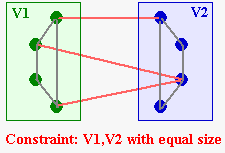The Minimum Graph Bisection Problem

Description:
The Bisection problem is a classified NP-hard optimization problem. It can be defined as:
Input:
-Undirected and unweighted graph G=(V,E).
Output:
-A partition of V into disjoint
sets {V1,V2}
with the same size.
Question
A bisection of a graph G=(V,E) with
an even number of vertices is a pair of disjoint subsets V1,V2
![]() V of equal size.
The cost of a bisection is the number of edges c=(a,b)
V of equal size.
The cost of a bisection is the number of edges c=(a,b) ![]() E such that a
E such that a ![]() V1 and b
V1 and b ![]() V2. The problem of Graph Bisection takes as input a graph with
an even number of vertices and returns a bisection of minimum
cost.
V2. The problem of Graph Bisection takes as input a graph with
an even number of vertices and returns a bisection of minimum
cost.
This problem arises frequently in real world applications, such as parallel scientific computing, VLSI design, or task scheduling.
Problem Instances
In order to define an instance of this problem we need to provide all the information about the Graph. This means: his Vertex Set and the associated Edge Set between pairs of vertexs. The edges are unweighted.
Related Bibliography and Papers
|
TextBook
|
Computers and Intractability: A Guide to the Theory of Np-Completeness by Michael R. Garey, David S. Johnson |
|
TextBook
|
How to Solve It: Modern Heuristics by Zbigniew Michalewicz, David B. Fogel |
| TextBook | Graph Bisection by Andras Ferencz, Robert Szewczyk, Jonathan Weinstein, Jon Wilkening |
|
URL
|
A compendium of NP optimization problems http://www.nada.kth.se/~viggo/problemlist/compendium.html |
![]()
Last Updated:
5/06/03
For
any question or suggestion, click here
to contact with us.
